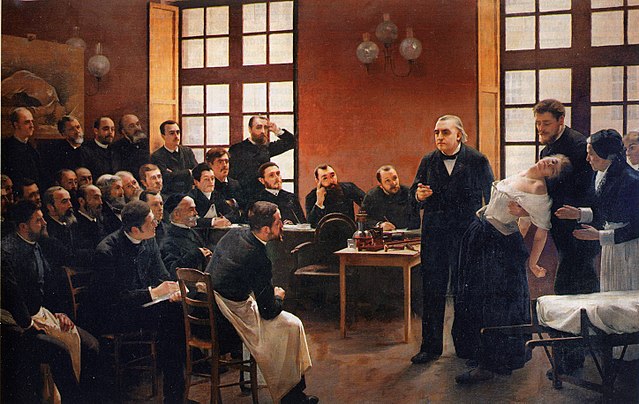The Hard Taco song for May, "The Lesion," is the new theme song for our history of medicine-themed board game by the same name.
The late 19th century was a momentous era of medical discovery. Hundreds of new neurologic diseases, syndromes, signs, and reflexes were discovered and described by otherwise brilliant men who lacked the creativity to come up with names for anything other than their own.
Jean-Martin Charcot has 12 medical terms associated with his name, including a joint, a foot, several diseases, two triads, a crystal, and an aneurysm. Joseph Babinski donated his surname to four signs, two reflexes, a test, a rule, and at least six syndromes.
 |
| Charcot demonstrates a classic case of the Charcot's sign in a patient with Charcot's syndrome to a roomful of admirers, who were known as the Great White Charcs. |
The Guppy - Named for the British naturalist Robert Guppy who discovered the small fish while skinny-dipping in Trinidad in 1866. Colleagues noted that Guppy was pretty much naked all the time, which is how he came to be known as a "naturalist."
Braille and Morse Code - Louis Braille and Samuel Morse engaged in a much-publicized race to discover the best use for the most fashionable new invention of 1830, the dot.
The Caesar salad - The main ingredients, Romaine, Worcestershire, Dijon, and Parmesan, were all regions in Europe where Julius Caesar owned rental properties.
The Apgar Score - The method to quickly summarize the health of the newborn was named for New York anesthesiologist Virginia Apgar, whose last name became a convenient acronym for a friendly competition among hospital staff. Doctors and nurses would give themselves points for refraining from subjecting whiny newborns to Asphyxiation, Pummeling, Garroting, Arsenic poisoning, and Radiation exposure.
The Petri Dish - Julius Richard Petri was trying to make molds for Jell-O shots, when one of his Jell-O shots grew mold. And the rest is history.
Shrapnel - Let me just go back to Petri for a second. The phrase, "the rest is history" is a cliché. Obviously, history did not start at that moment. That was rotten writing, and you deserve better from me. Anyway, Henry Shrapnel was a British artillery officer who found a more efficient way to mutilate people. Everything that happened before, during, and after that moment is history.
The Teddy Bear - To prepare for foreign policy meetings, hairy-backed Theodore Roosevelt would barricade himself in the West Wing and pose for boudoir photos in the one-piece satin lingerie that now bears his name.
The Leotard - French engineer Jules Leotard developed the first self-propelled ice resurfacer, but a mix-up at the patent office left Leotard's name on the product license filed by acrobat and costume designer Frank Zamboni.
The Jacuzzi - The ghost of Italian inventor Candido Jacuzzi spends most of the afterlife haunting hotel owners who falsely advertise in-room Jacuzzis, when what they really offer is off-brand hot tub time machines.
The Stairwell - Named for the popular Game of Thrones character Stairwell Tarly.
With warmest regards,
Zach